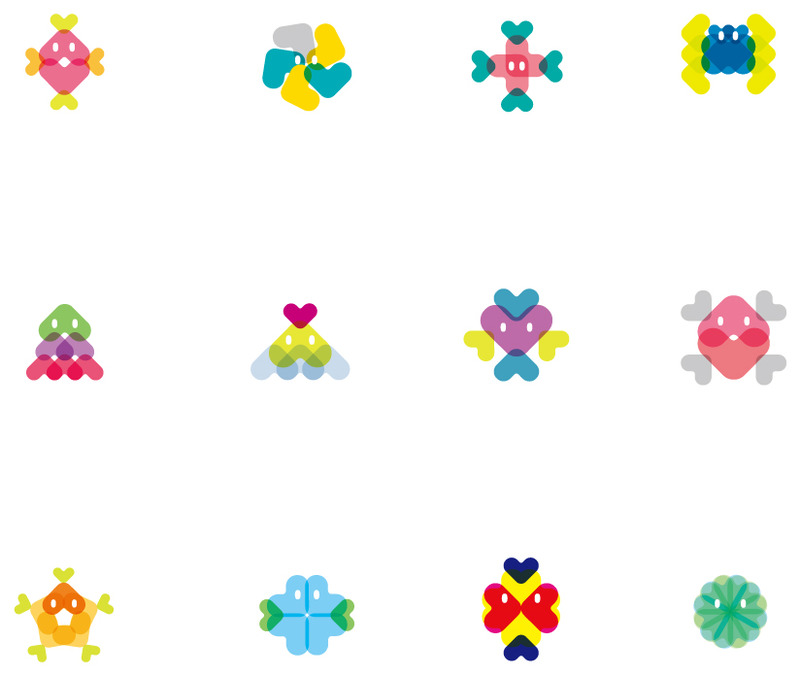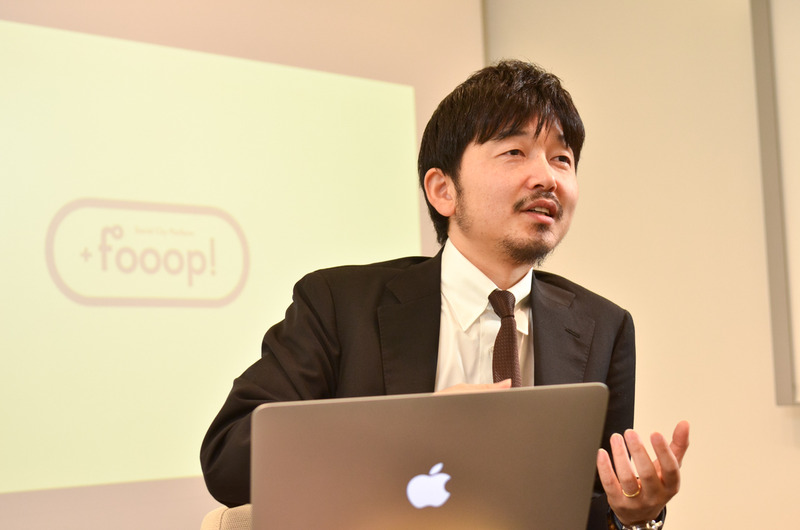Dentsu Inc. International Information Services (ISID)'s Open Innovation Laboratory (InnoLab) is currently challenging itself to create an entirely new kind of city using IT.
In this fifth installment of the series, we speak with Junichi Suzuki, an InnoLab researcher and the mastermind behind the Social City, about the world's first IT platform, "+fooop!".

What is the "Compass Service" born from "+fooop!" that nurtures cities?
――Please tell us about the social city platform "+fooop!".
Suzuki: "+fooop!" is both the brand name for ISID's newly commercialized urban IT platform and the concept name for the research and development project spearheaded by INOLAB. The first phase of the "+fooop!" project, the large-scale complex "Grand Front Osaka," is a prime example embodying both these elements. It features the "Compass Service," a city communication infrastructure system jointly planned and developed by ISID with the city's operators. Beyond providing established functions and services, it also serves as a massive testing ground for rapidly implementing and experimenting with the latest technologies.
The "Compass Service" is a navigation and communication tool for the city, providing information tailored to each user's needs. It can be accessed via the touch-panel digital signage "Compass Touch" installed throughout the facility and the smartphone app "Compass App". After downloading the "Compass App" and answering a few questions, a personalized navigation character called "Kupī" appears, tailored to your individual type. You can follow Kupī's guidance to visit stores, or use the app's "Town Tweets" feature to post reviews of shops and facilities... The "Town Friends" feature lets you connect with friends in the city, and by linking with Facebook or Twitter, you can import your social graph from SNS.
"Compass Touch" enhances the experience by allowing users to touch their IC card on any of the 36 digital signage displays installed throughout Grand Front Osaka. Logging in here also brings out "Kupi," who asks a few questions to get to know the user. Even without a smartphone, users can enjoy interacting with "Kupi" while getting the latest city updates and event information. By linking with the "Compass App," users can check personalized information from either device.
While the "Compass Service" appears relatively simple to users, a significant amount of information is actively processed behind the scenes. The 12 types of "Kupi" are simplified categories based on thousands of personality profiles we created. Beyond the 36 digital signage units, we assign a massive number of spot IDs not just to commercial facilities, but also to individual units like deck spaces, gardens, and bridges. By accumulating and linking all this information, the "Compass Service" learns the behavioral characteristics of each individual user.
 |
| 12 Types of "Kupis" |
Predicting consumer behavior through check-in functionality and tagging across extensive spot IDs
――What specific data is collected and stored at "Grand Front Osaka"?
Suzuki: First, visit history. We have a system where shopping earns 1 point per 100 yen spent, and we check in at the point accumulation stage. Then, similar to familiar tagging or check-in functions on Facebook or Twitter, we capture behavioral history showing who went where. At Grand Front Osaka, as mentioned earlier, spot IDs are assigned everywhere throughout the complex. This means users can check in not just at stores, but also at locations like plazas and staircases to mark their memories. Moreover, when recording a visit, users can select from eight reasons why they came to that location. For example, if Person A visits a restaurant on a Friday night "because it's an anniversary," and Person B is tagged there, we can infer a deep relationship between them. If that relationship remains intact, there's a possibility they'll return for the next anniversary. This allows the city and stores to develop targeted approaches and services for that occasion.
Additionally, to accurately measure smartphone locations, we've placed sensing devices from Koozyt, Inc., an ISID group company, throughout the area. This allows us to pinpoint smartphone locations with an accuracy of 3 to 5 meters, revealing how far apart visitors and their companions are and where they are moving. If someone stays for an hour, we can determine whether they came with an acquaintance, as part of a group, or alone. By accumulating, analyzing, and utilizing this diverse data, we believe Grand Front Osaka will continue to evolve.

We will make Grand Front Osaka the world's most advanced city over the next five years!
――I understand data is being used for urban development, but with so much information being tracked, might some people react negatively...?
Suzuki: We obtain permission for all data collection. Furthermore, users can set detailed privacy levels for check-in information, such as whether to share only with friends, share publicly, or allow invitations from friends. We also offer services where the more data you share, the more benefits you receive. Visitors seem to fully understand and agree with this approach.
Furthermore, the information we gather via NFC and sensing devices is associated based on anonymous IDs. We categorize characteristics linked to these IDs and then market to those typified characteristics in a way that connects back to the ID. It is absolutely never tied to personal information like "Mr. Aoyama from Minato Ward," so please don't worry about that point.
――I see, that's reassuring (laughs). So, how will Grand Front Osaka develop going forward?
Suzuki: The city operators have told us, "Make this the world's most advanced city over the next five years." GranFront Osaka's strength lies in its infrastructure – we can capture visit history, movement history, and even link with SNS. As ICT specialists, we feel like we can propose anything. We want to find technologies and business models that only innovators have dabbled in so far, then leverage GranFront Osaka's IT infrastructure and data to adapt and actively incorporate them. If we discover any amazing technology, we plan to implement it at GranFront Osaka first. Please look forward to our future developments.
(Continued in Part 6 )





